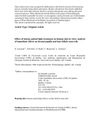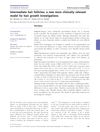TLDR Encapsulated human hair cells can substitute for natural hair cells to grow hair.
In the 2008 study, researchers successfully demonstrated that microencapsulated human hair dermal papilla (DP) cells could act as a substitute for dermal papilla in hair follicle regeneration. By enclosing DP cells in an alginate-polylysine-alginate (APA) semipermeable membrane and implanting them into rat footpads, they observed the formation of hair follicle and sebaceous gland structures within 6-10 weeks, with hair fibers visible at 10 weeks. This suggests that microencapsulated DP cells retain their normal activity and can initiate follicle regeneration, offering a new method for studying hair growth mechanisms and the role of the dermis in this process.
32 citations
,
August 2006 in “Archives of Dermatological Research” Dermal papilla cells can help regrow hair follicles.
231 citations
,
December 1999 in “Journal of Investigative Dermatology” Hair follicle size is mainly influenced by the number of cells and extracellular matrix volume, with cell number having a larger impact.
125 citations
,
August 1992 in “Development” Implanted dermal papillae can induce hair growth in rat ear wounds.
106 citations
,
April 1986 in “British Journal of Dermatology” Dermal papilla cells from human hair follicles form unique structures and don't live as long as other skin cells in lab conditions.
 6 citations
,
June 2013 in “British Journal of Dermatology”
6 citations
,
June 2013 in “British Journal of Dermatology” Intense pulsed light treatment mainly damages pigmented hair parts but spares stem cells, allowing hair to regrow.
 41 citations
,
June 2013 in “PLOS ONE”
41 citations
,
June 2013 in “PLOS ONE” Engineered skin substitutes can grow hair but have limitations like missing sebaceous glands and hair not breaking through the skin naturally.
 30 citations
,
May 2010 in “British Journal of Dermatology”
30 citations
,
May 2010 in “British Journal of Dermatology” Intermediate hair follicles are a better model for studying hair growth and testing hair loss treatments.
January 2009 in “Chinese Journal of Aesthetic Medicine” The treatment helped regrow hair in people with androgenetic alopecia.
 66 citations
,
August 2001 in “Experimental Dermatology”
66 citations
,
August 2001 in “Experimental Dermatology” Human hair follicle cells can grow hair when put into mouse skin if they stay in contact with mouse cells.




